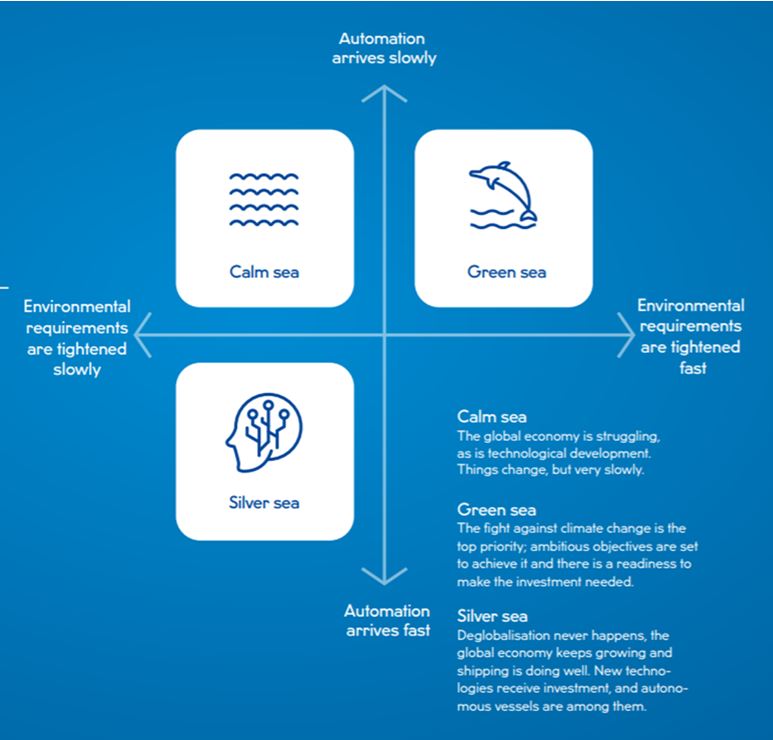One new ship coming under the Estonian flag could generate 45,000–240,000 euros in tax revenue from the on-shore sector. The exact amount would depend on how interested shipping companies are in the products and services offered by our on-shore sector.
What should be done for Estonia to be a competitive flag state in 2040?
Quite evidently, nobody can know what the world will be like in twenty years from now as many different developments are possible. In what follows we combine major trends to propose three scenarios that are realistic but quite different, so that we can consider future problems and be better prepared for them.
The scenarios were created with two main driving factors, which are the pace at which the maritime transport ecosystem becomes automated, and the pace at which environmental requirements are tightened. Combining these factors gave us three future scenarios:

Calm sea
The global economy is fragmenting and regionalising. International agreements on environmental and technological standards prove difficult to sign. Technology develops more slowly in maritime affairs than expected. Growth in the global economy and consequently in maritime transport is struggling. Information is now exchanged digitally in the maritime transport ecosystem, but the development of autonomous systems has been sluggish, so ships are generally still operated as they are today even though they are more modern. The environmental requirements have tightened a little but no new carbon-free ship fuel has emerged, and it is unrealistic to think that CO2 emissions will be reduced by 50% by 2050.
Green sea
The fight against climate change is the top priority. It has been decided to cut carbon emissions from ships to zero by 2050. All new ships sail on carbon-free fuel and older ships are being rebuilt. The maritime transport ecosystem is digitalising like in the Calm sea scenario. There is less focus on developing autonomous systems because the investment pressure is on meeting the environmental requirements, but the development is still faster than in the Calm sea scenario. Even so, the great majority of ships are still human-operated in 2040.
Silver sea
Deglobalisation never happens and after some temporary disruptions, the world moves on again, a little more slowly perhaps, but still following a course of integration. The economy is thriving and automation has increased in the maritime transport ecosystem. The communication between the parties in the ecosystem is digital, and some autonomous ships, both human-operated from the shore and fully autonomous, are used in both short sea and ocean shipping. They form a growing part of the fleet, and more and more ports are capable of receiving, unloading and loading them with little human intervention. A more moderaate schedule for reducing carbon dioxide emissions has been agreed on than that in the Green sea scenario, with a cut in the level to 50% of that of 2008 by 2060. Several different lower-carbon emission ship fuels and engine solutions are in use.
Key Conclusions
It is always wise to have a user-friendly ship register that supports digital communication between different actors in the shipping ecosystem and can provide data-rich additional services to shipowners.
It is important to resolve the issues that restrict competitiveness in the defence of ships, the handling of weapons, ship registrations, and labour law.
To make costs more competitive, the registration fees and labour taxes of the second bareboat chartered ships register should be revised.
An active partnership with the private sector is crucially needed to search for technological solutions that could cut the size of ships’ crews without making any compromises in safety.
A plan needs to be prepared to develop the sales and on-shore sectors of the ship registers.
To play a role in the International Maritime Organization, it would be best to find a narrow topic like digitalisation to champion and promote.
Authors: Sten Anspal, Janno Järve, Tõnis Hunt, Epp Kallaste, Laura Kivi from Estonian Centre for Applied Research CentAR

 An independent think tank at the Riigikogu
An independent think tank at the Riigikogu